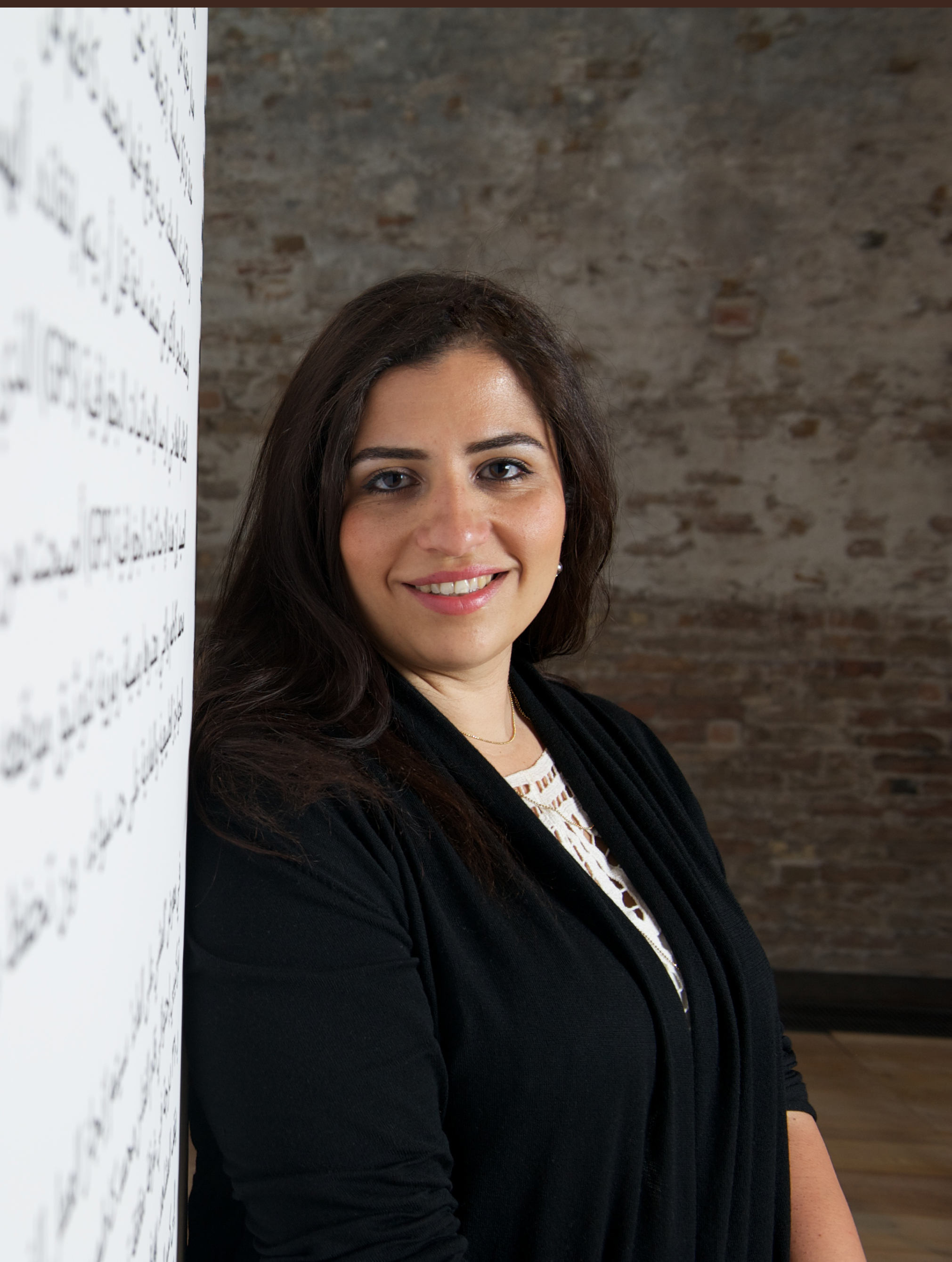The inaugural exhibition at the Palestinian Museum, Jerusalem Lives, is made up of questions that are generated from the politics faced by the city of Jerusalem today. If we consider Jerusalem as the quintessential global city, we must ask whether its current condition, its vaults of histories, reflects how cities worldwide aspire to the universal and fall short on the shores of globalization. If so, can we find correlations between the dissection of minority neighborhoods in global cities and the division of various quarters in the Old City? The exhibition establishes the city of Jerusalem as both the source of globalization and the site of its failures. The city lends itself as the ideal case study for understanding globalization’s ideology and reckoning with its collapse. For if globalization can be thought of as a phenomenon that sparked in Jerusalem – an open, cosmopolitan, and multicultural city – then it is also possible to consider the failures of globalization in this city that is now divided and under military occupation, defined by exclusionary policies. Zoning, house demolitions, and a stifled economy have led to the death of the city. These systems of oppression and power have become acceptable, the norm, thus allowing the failures to leak out to other cities as the new world order continues to propagate xenophobic and intolerant rhetoric – which succeeded in dividing Jerusalem – to further infect and divide other cities throughout the world.
How does this quintessential universal city, home to the three monotheistic religions, become forsaken and lifeless? The Israeli occupation, with its systematic policies of control, exclusion, and annexation, is annihilating the very fabric of a once global, diverse, and lively Jerusalem. The Palestinian community that lives in the city struggles to salvage its basic rights, while the world not only turns a blind eye but accepts without question the injustices inflicted upon Palestinians in Jerusalem. To understand this failing militarized version of Jerusalem is to also understand the failings of other major cities such as Paris, London, or New York, where segregation, security, and surveillance stifle the diversity of their urban and social fabrics, becoming the norms of a new controlled global order.
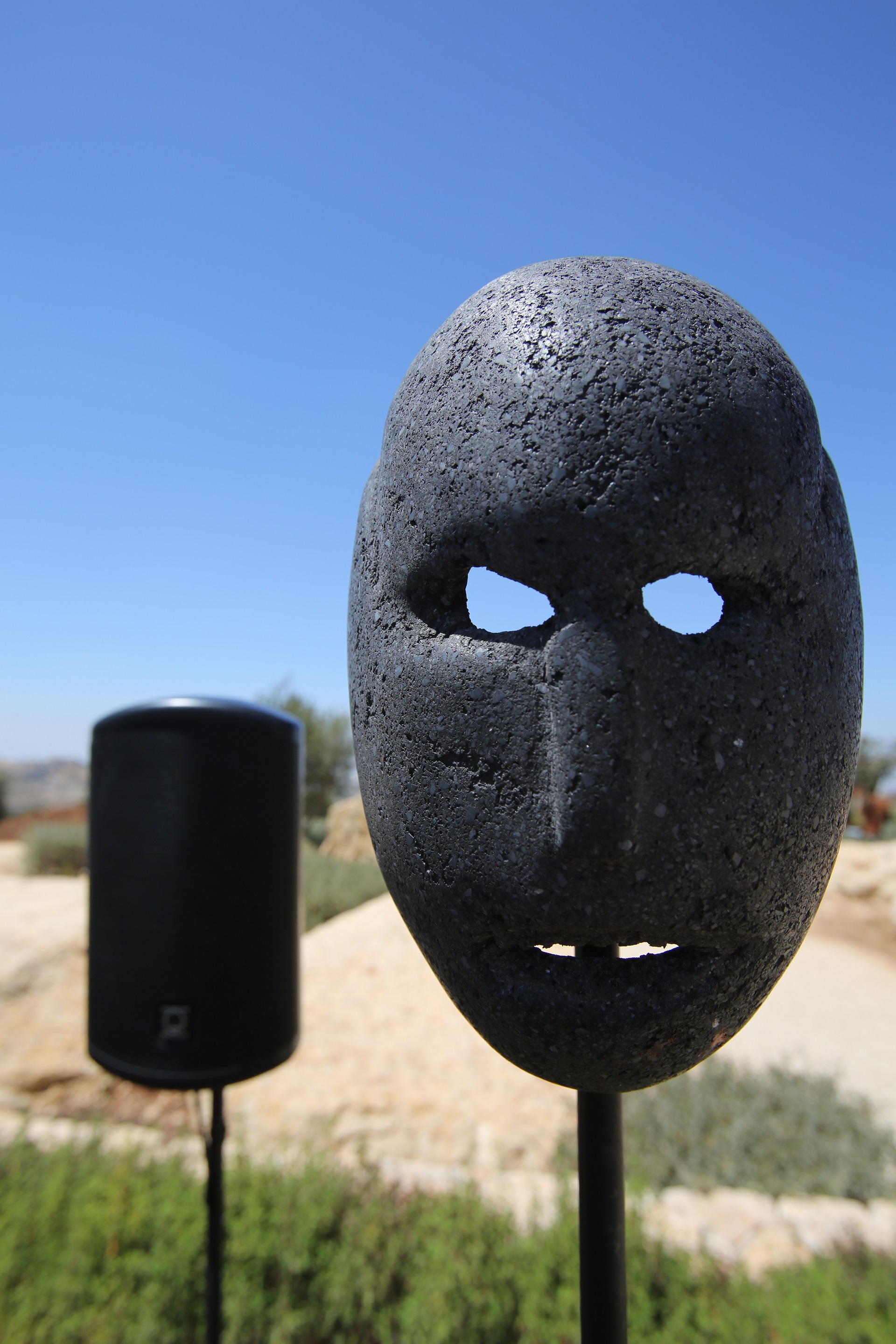
Four 3D-printed marble masks, 5-channel sound installation, dimensions variable.
Photo by Ziad Trad. © The Palestinian Museum.
In order to study and understand a city, one must explore its cultural, political, environmental, economic, and ideological perspectives, and it is through this lens that the exhibition explores Jerusalem and the failures of globalization within it. It has become apparent that the following essential topics have determined the conditions of globalization in the contested city: culture – whether through popular culture, media, or image making; the politics of colonialism, imperialism, and gentrification; economy and the thriving military-industrial complex; and finally, the making of ideology through the marketing of religion and tourism.
This study is demonstrated in Jerusalem Lives’ central exhibition that is flanked by research and attempts to examine Jerusalem as a case study that metaphorically represents globalization and its failures, and finds answers to inspire a better future by focusing on the living aspect of the city. Veering away from clichés, the exhibition aims to expose the neoliberal colonial and imperial challenges imposed by the Israeli occupation that Jerusalem and its people are facing. Could the title Tahya Al Quds be transformed from a mere slogan to presenting real content and support for life in the city? What are the stories of collective resistance? How do we make Jerusalem live?
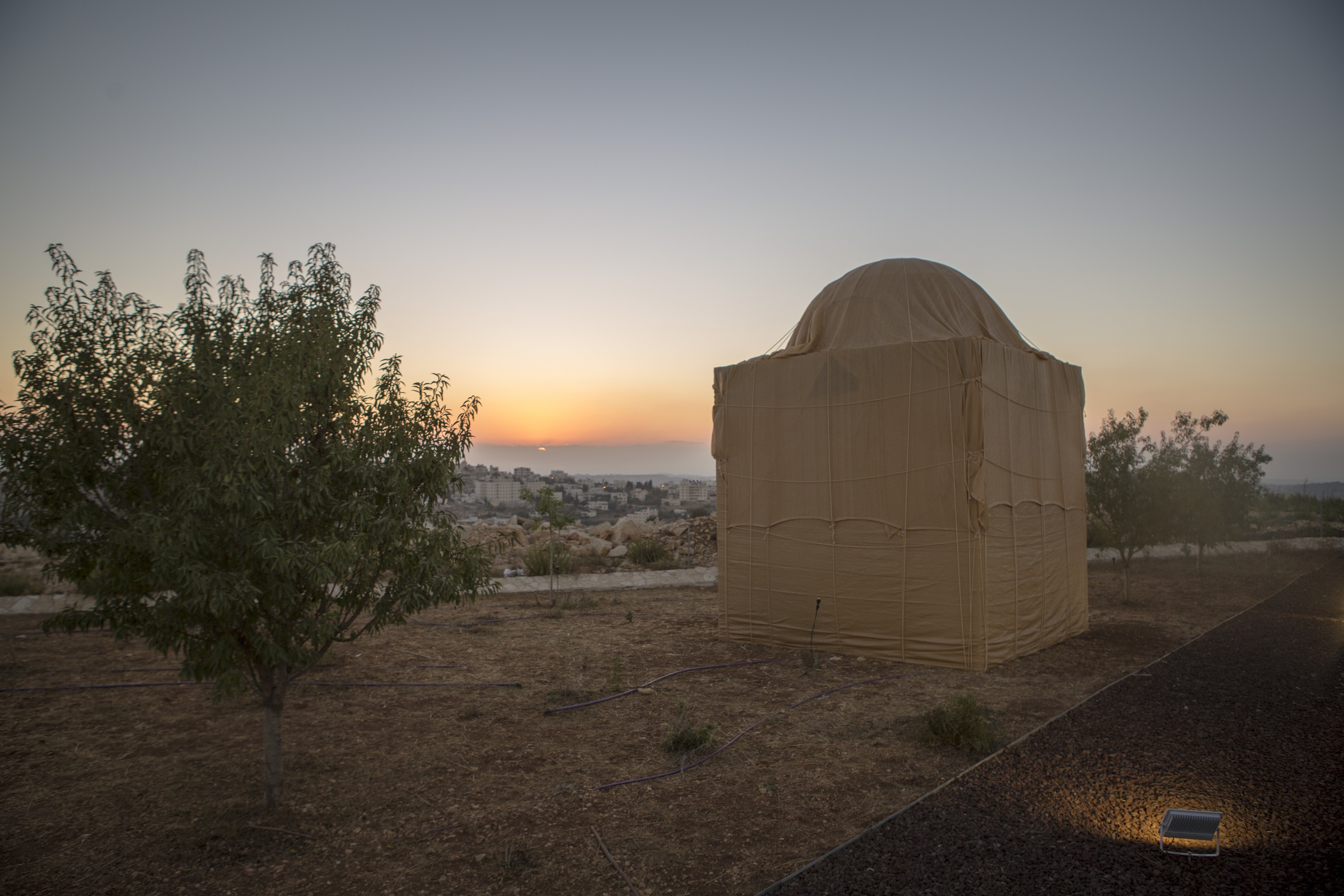
Wood, tarpaulin, dimensions variable.
Photo by Ziad Trad. © The Palestinian Museum.
The following five sections in this essay correspond to the sections highlighted in the exhibition that study the phenomena of globalization as applied to Jerusalem, from economic, political, ideological, and cultural standpoints. It highlights the collective ways that people have resisted this hegemonic order of depriving them of their rights and rendering the city bereft of life. The focus is on demonstrating the work of civic institutions in Jerusalem that have adopted a long-term approach of perseverance and resistance. In addition, the work of various pioneering artists, both established and contemporary, presents an avant-garde perspective that shows how they have identified the most urgent issues vis-à-vis Jerusalem.
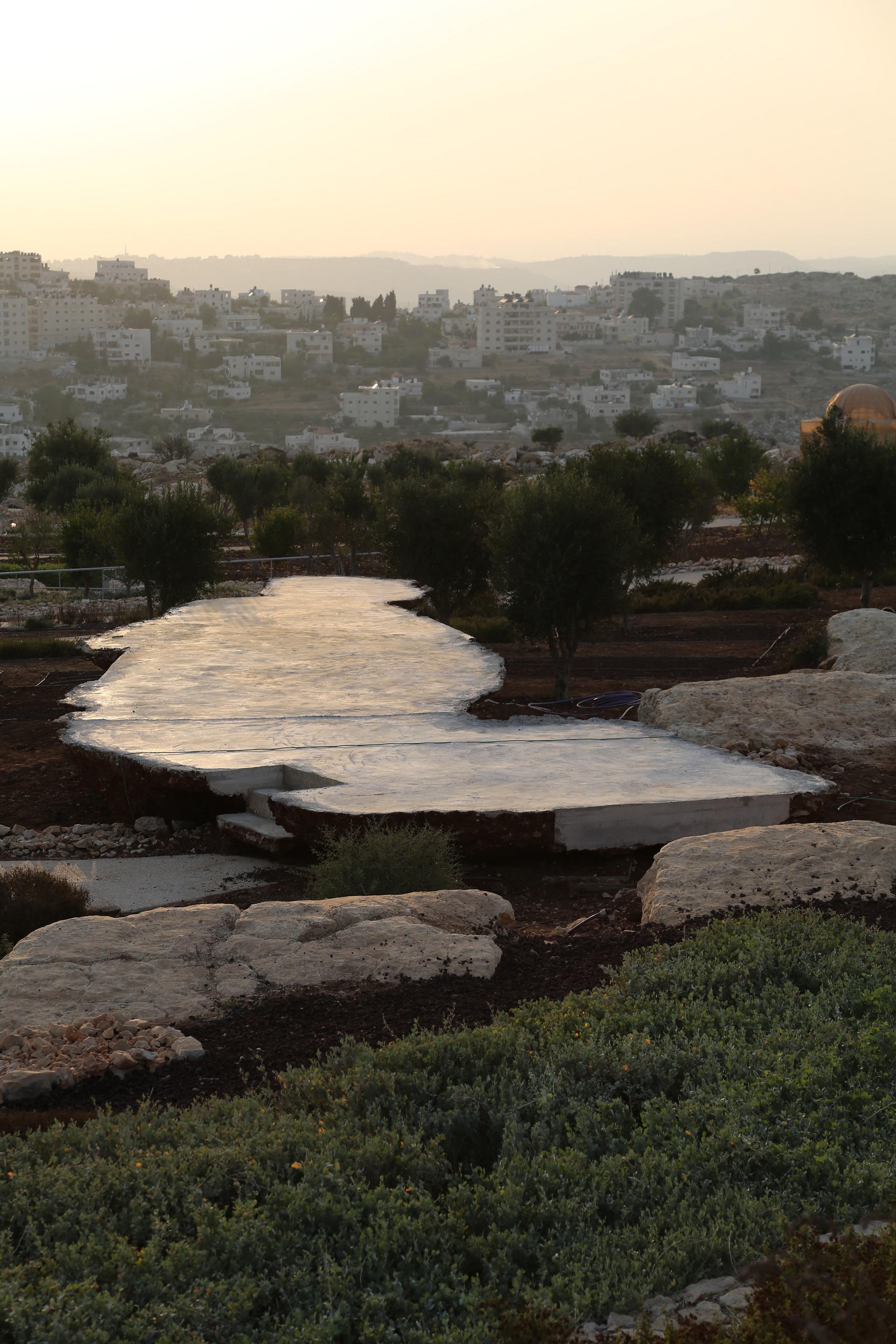
Concrete, steel reinforcement, soil, 1,850 x 800 x 200 cm.
Photo by Hamoudi Trad. © The Palestinian Museum.
CULTURE: Popular Culture, Media, and Image Making of the City
The focus of this section is to set the stage in order to help us see Jerusalem as it has been portrayed and imagined visually and culturally during the past century. As with any other global city, images that stand for the city of Jerusalem are produced and circulated ad infinitum in the media. The Dome of the Rock has become a representative emblem of the city and is reproduced in a plethora of forms: logos, billboards, tourist merchandise, and shop signs, as was documented by photographer Ahed Izhiman with photos from all over Palestine that display this reality. The names Jerusalem or Al-Aqsa can be found adorning many shops, streets, roads, and even other cities throughout the world. In the United States alone, there are tens of cities and major roads that are named Jerusalem. In Palestinian and world cinema, Jerusalem has been endlessly filmed, documented, and imagined. Mohanad Yaqubi was commissioned to create a four-screen montage of historical and contemporary footage sourced from historical and contemporary documentaries to world media coverage and even Hollywood movies, all in an attempt to capture or represent Jerusalem through film. Printed matter such as posters and stamps ensure that Al-Quds and its famous symbols are widely circulated. Ali Kazak has donated to the Palestinian Museum a number of original political posters that he has collected since the 1960s, many of which focus on Jerusalem. As a rite of passage, Palestinian political prisoners serving a sentence in Israeli jails pass their time producing intricate 3D models of the Dome of the Rock using threads and beads. And Jerusalem, like any global city, has produced its fair share of ephemera and tourist items, from key chains to T-shirts and memorabilia, etc. But what is also unearthed is literature’s contribution to knowledge-making about the city, which features a selection of books from the Al-Budeiri Library and Archive. The library, initiated by the Jerusalemite Sheikh Mohammad Ibn Budeir (1747–1805) and located in the Old City, contains roughly 900 manuscripts that date back to the twelfth century.
Most importantly, artists also present a nuanced and critical voice, proving that Jerusalem is not just a distant icon but a city that is made up of the lives of people. The selection of paintings on display in the exhibition by master artists such as Nabil Anani, Abdul Hay Mossalam, Tayseer Barakat, and Sliman Mansour all focus on the people, whereas the symbols of the city become ancillary or even subsidiary in the background. They all seem to emphasize that the city is made up of its people. In 1973, Sliman Mansour produced Camel of Hardships (jamal al-mahamel), which has become a famous icon that represents the Palestinian plight. An old porter is seen carrying Jerusalem on his back. The original 1973 sketch, part of the collection of Yvette and Mazen Qupty, shows the full figure of the man standing while the icon of the city is barely distinguishable.
POLITICS AND ENVIRONMENT: Colonialism, Mapping, and Strategies of Control
In this section, the focus narrows to the Israeli policies of colonization and control that have been imposed on Jerusalem since its occupation, stifling the lives of Palestinians in the city. How does the dream of a Jerusalem as global and free transform into a gated and restricted city? Commissioned infographic posters and animated videos by graphic designer Dennis Sobeh give extensive information and statistics about checkpoints, house demolitions, residence revocations, and other plights that demonstrate the ongoing enforced Israeli annexation of the city. The neighborhood of Silwan suffers continually from takeover plots by Israeli settlers. Checkpoints, such as the infamous Qalandiya Checkpoint, bar every entrance to the city.
Artists have had an almost prudent and even prophetic role in looking at and representing the city. Rula Halawani and Simone Bitton recorded the expansion of the Wall, in photo and film, when it was barely a visible subject in the media. Mona Hatoum created the soap installation Present Tense, with its representation of the dwindling map of Palestine post-Oslo Agreement, as early as 1996, during a residency in Jerusalem. Thirty years after his assassination, Naji al-Ali’s caricatures continue to be revered and ring prophetically true; on display here are 14 drawings that he made during the mid-1970s and 1980s which all tackle Jerusalem. One of the drawings prophetically depicts the Dome of the Rock, symbolizing Jerusalem, being walled off. Towards the end of this section, commissioned artist Ahed Izhiman has created a panoramic, stitched photograph investigating the ring of settlements that encircle Jerusalem, slowly cutting it off. This section also highlights the resistance mechanisms of the work of some institutions and collectives, such as the Silwan Club, the African Quarter, and Grassroots Jerusalem that continue to persevere with a self-determined voice in the face of Israeli oppression.
ECONOMY: The Military-Industrial Complex
Israel has created an economy that it exports globally: the security and surveillance systems it has developed for its militarized procedures, and which it manufactures in order to control Palestinian cities, especially Jerusalem. This is nothing less than an industry, with US$6.5 billion in revenue, as is pointed out in the latest infographs. These systems are being normalized and exported worldwide. Many of the trials and tests they require are carried out on Palestinians within the parameters of the city of Jerusalem. The Wall is a case in point; in January 2017 Netanyahu was documented promoting the Wall on Twitter to Trump, hailing his project to build a wall in Mexico. An article in Haaretz that was published on September 13, 2017, points out that “Elta North America, an Israeli-owned defense manufacturer, was one of four companies chosen to build a prototype for the border wall between the United States and Mexico.”i
In the meantime, tourism is being stifled. The Old City’s shops and bazaars are not bustling with life, as they should be. Shop owners have to pay a heavy Israeli tax known as arnuna,ii and many are forced out, so a vibrant healthy Palestinian economy is not allowed to prosper. The Mumbai-based artist collective CAMP created a film Al jaar qabla al daar (The Neighbor before the House), 2009–2011, using surveillance cameras, referencing the MABAT 2000 – the surveillance system surrounding the Old City that targets Palestinians. It includes an observation station linked to nearly 400 security CCTV cameras spread throughout the Old City of Jerusalem. The center contains 36 hi-tech touch screens that constantly receive images from the CCTV cameras. The station is manned by 12 highly trained officers over 3 shifts, 24 hours a day, 7 days a week, to provide a “strategic advantage” to the hundreds of officers on foot patrol throughout the labyrinth-like city with a population of some 35,000 residents.
Bisan Abu Eisheh’s video installation depicts the reality faced by shops in Jerusalem today versus a clear strategy that aims to steer tourism towards West Jerusalem as is propagated in the highlighted pages of the travel guides that accompany the videos. An Israeli website illustrates a new trend being promoted for tourists to Israel, where the tourists can come to boot camps and train in how to “combat terrorism.” These daunting realities being faced by the city of Jerusalem and its people are a direct result of the continued Israeli occupation and its mechanisms of control.
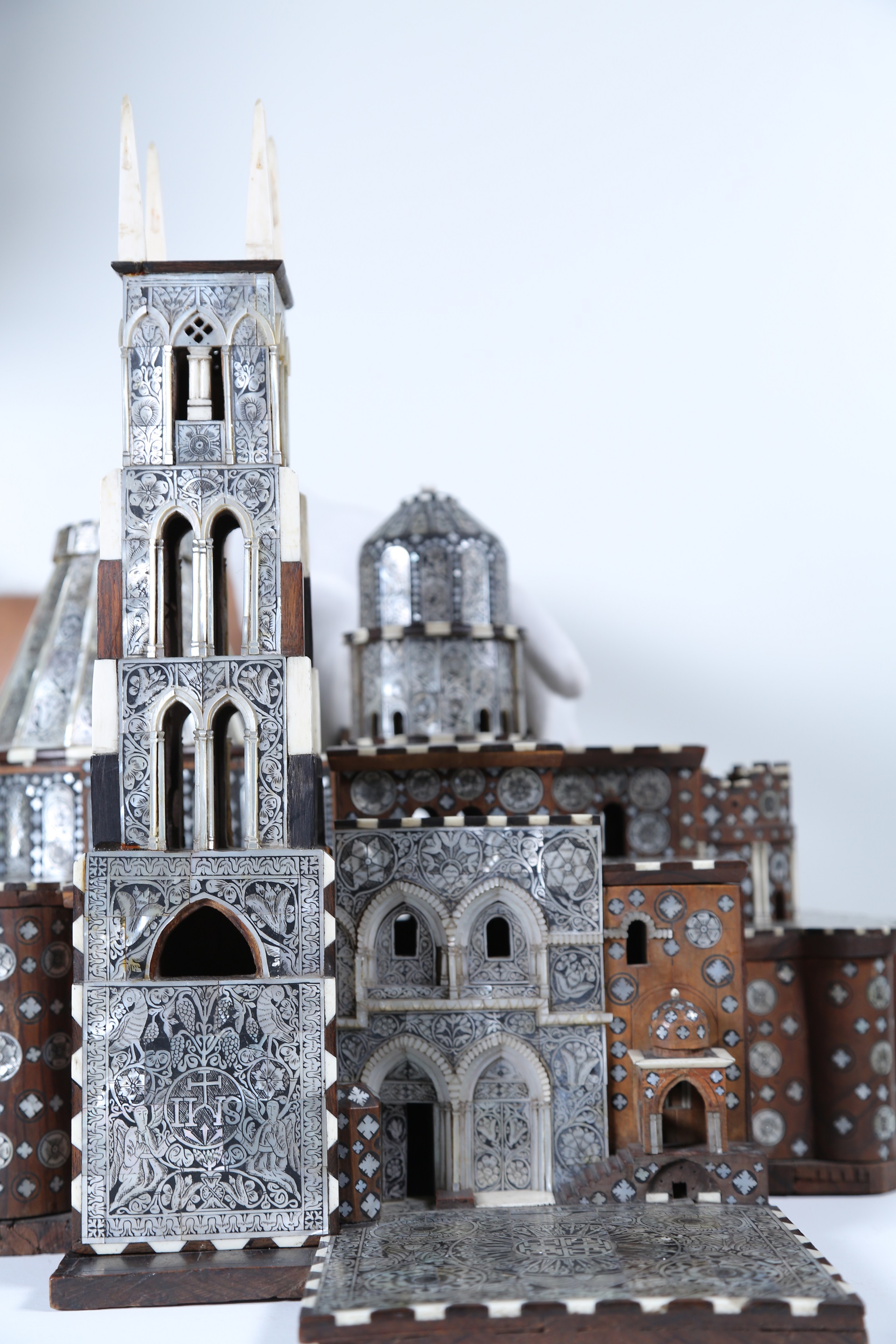
Olive wood, pistachio wood,
mother of pearl, camels’ bones, and ink.
George M. Al Ama Collection. Photo by Hamoudi Trad.
© The Palestinian Museum.
IDEOLOGY: Between the Sacred and the Living
Jerusalem is the birthplace of all three monotheistic religions, with billions of followers all over the world. Pilgrims have historically descended on the city, as is evident in the Christian, Jewish, and Muslim certificates that are on display here which date back to the eighteenth century. The Church of the Holy Sepulcher, one of the most important churches in Christianity, is as revered as it is forsaken. A rare collectable, one of only 30 carved-wood-and-mother-of-pearl models of the church from the eighteenth century, is on display, part of the George M. Al-Ama Collection. Yet the numbers of visitors to the fourth-century Holy Sepulcher do not match the 25 million that visit the Basilica of the Sacré-Coeur in Paris, a church that is only a little over 100 years old, according to Travel+Leisure website in an article for the “World’s Most Visited Sacred Sites.”iii
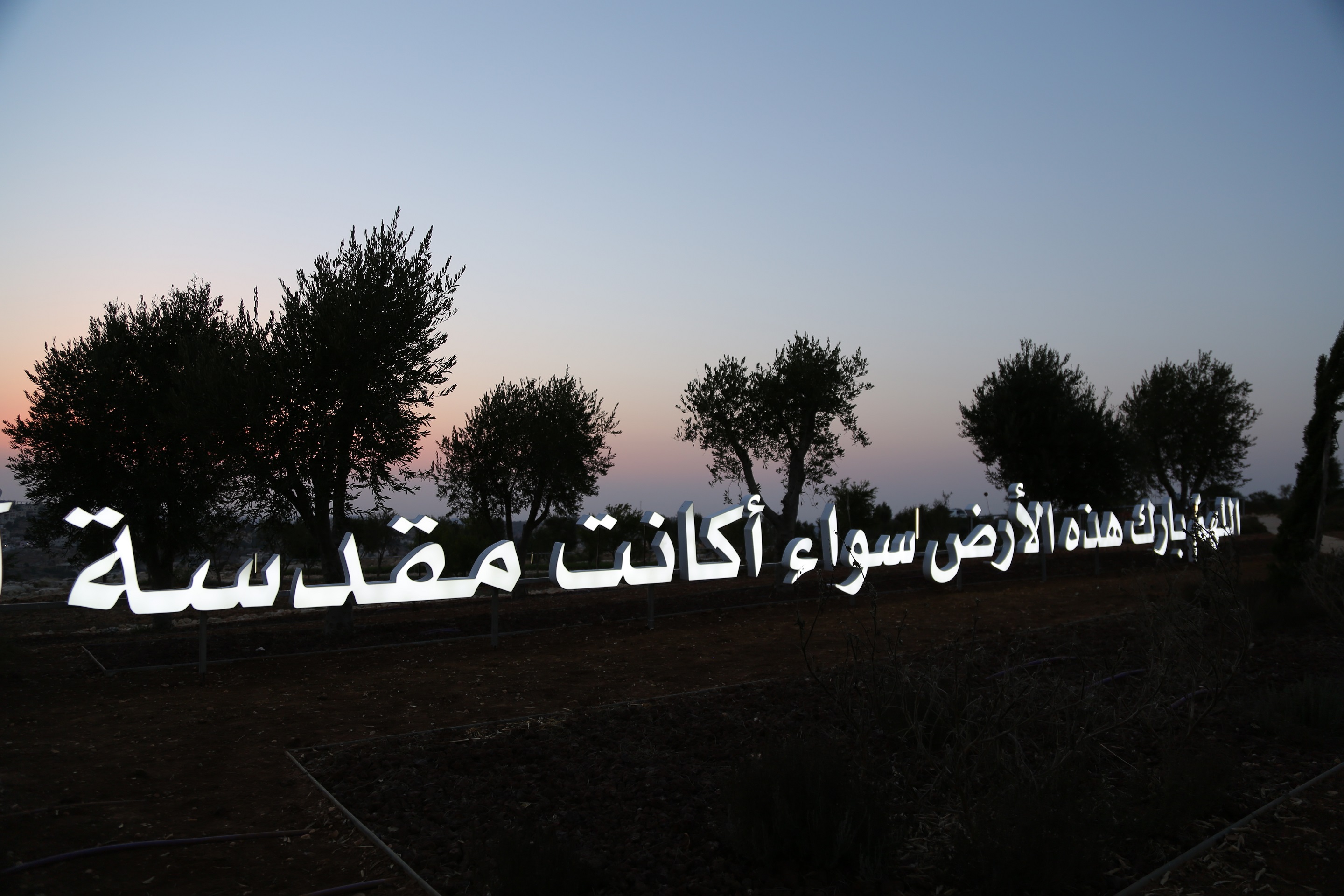
Light boxes, acrylic, PVC, National paint, LED, 1,850 x 120 cm.
Photo by Hamoudi Trad. © The Palestinian Museum.
In the meantime, Israel is planning to fully annex Jerusalem and announce it as the capital of the Jewish state. The danger of this rhetoric denies the multiplicity of the city and poses a direct threat to the Palestinians living there. This policy of Judaization is carried out unabashedly. On display in the exhibition is a video by an Israeli settler organization that describes the Arab and Palestinian demographic threat to the city and how it needs to be curtailed. Such colonial expansion is evident in the neighborhood of Silwan, where eviction orders issued to Palestinian households make way for the Zionist plan to build the Holy Basin surrounding the Old City. Yet recent events pertaining to the closure of Al-Aqsa compound by the Israeli authorities, which resulted in mass prayers and sit-ins, demonstrate how Palestinians continue to creatively resist in the face of this injustice.
CULTURE: Jerusalem Imagined
The final section of the central exhibition is dedicated to showing a selection of works by artists who have dealt poetically with Jerusalem, and celebrated the life of the city and its people in the face of its unbearable conditions. In abstraction, they have found refuge to dream a different reality for Jerusalem, to imagine it free, open, and more colorful. The works of veteran artists Kamal Boullata, Samia Halaby, Ibrahim Noubani, and Samir Salameh depict Jerusalem as a haven of nature and color, unobstructed and owned by the Palestinian imaginary. Presented in this part of the exhibition is a selection of ten actions performed by artist Emily Jacir and dedicated to the people of Jerusalem, excerpted from her seminal artwork Where We Come From (2001–2003). Jerusalem-born artist Vladimir Tamari, who recently passed away, is commemorated with a vibrant painting and his film Al-Quds that documents the lively and modern life of the city and its people prior to and since its seizure in 1967. In a bid to continue to demonstrate the actual lives that make the bedrock of Jerusalem, the section ends with the results of the Palestinian Museum’s open call, in which people were asked to send in their personal photos taken in front of the Dome of the Rock or Damascus Gate. Finally, the viewer is invited to wander through the gardens of the museum, where in the spirit of this artistic legacy, 18 artists have been invited to create various artworks that speak to the idea of Jerusalem. The result is an array of monumental sculptures and installations that mimic nature and the land, while speaking to rootedness, belonging, and openness, an antithesis to the closure faced by the city of Jerusalem.
i http://www.haaretz.com/us-news/1.812196.
ii Arnuna is a type of tax imposed on residential and commercial properties. High arnuna rates were the reason behind closing many Palestinian commercial stores in Jerusalem, especially in the Old City. The rates of arnuna fees accumulate to hundreds of thousands of Israeli shekels.
iii http://www.travelandleisure.com/slideshows/worlds-most-visited-sacred-sites#26.

